Project Quality Management Report: INF80044 Module, University
VerifiedAdded on 2022/10/17
|9
|2355
|259
Report
AI Summary
This report provides a comprehensive overview of project quality management, encompassing key concepts and practical applications. It begins by defining product quality management and its significance in organizations, emphasizing its role in customer satisfaction and regulatory compliance. The report then delves into the core elements of product quality management, including quality planning, quality control, quality assurance, and quality improvement. It further explores the concept of the cost of quality, categorizing costs into prevention, appraisal, internal failure, and external failure. The report then examines project quality planning, highlighting its role in setting benchmarks and managing quality standards throughout the project lifecycle. It also discusses project quality assurance, emphasizing its role in meeting quality requirements and providing customer satisfaction. Finally, the report covers project quality control, detailing techniques and tools used to ensure product quality and meet customer needs, including seven common quality control tools such as flowcharts, check sheets, cause-and-effect diagrams, Pareto charts, histograms, control charts, and scatter diagrams. The report concludes by emphasizing the importance of these tools in achieving customer satisfaction and gaining a competitive edge in the marketplace.
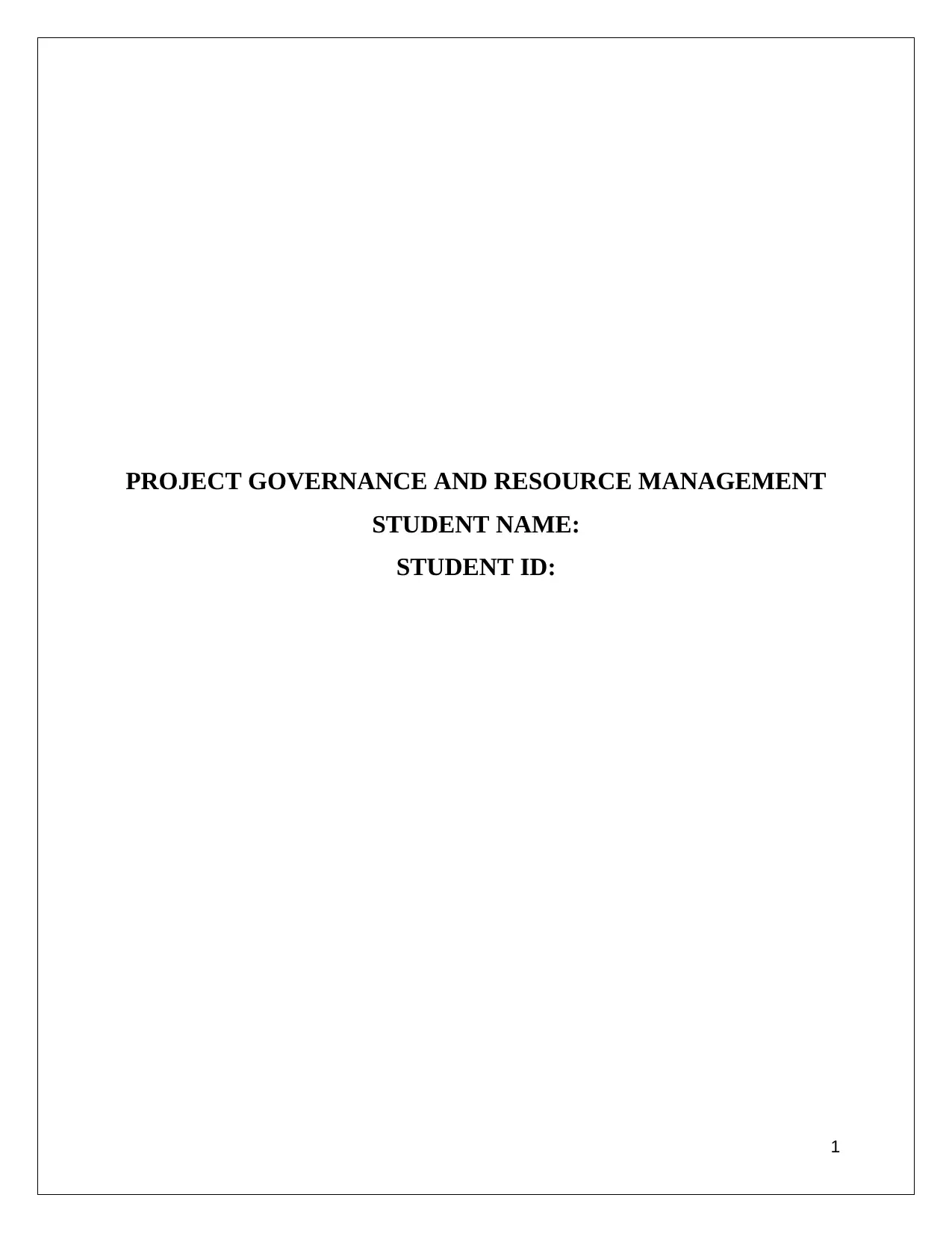
PROJECT GOVERNANCE AND RESOURCE MANAGEMENT
STUDENT NAME:
STUDENT ID:
1
STUDENT NAME:
STUDENT ID:
1
Paraphrase This Document
Need a fresh take? Get an instant paraphrase of this document with our AI Paraphraser
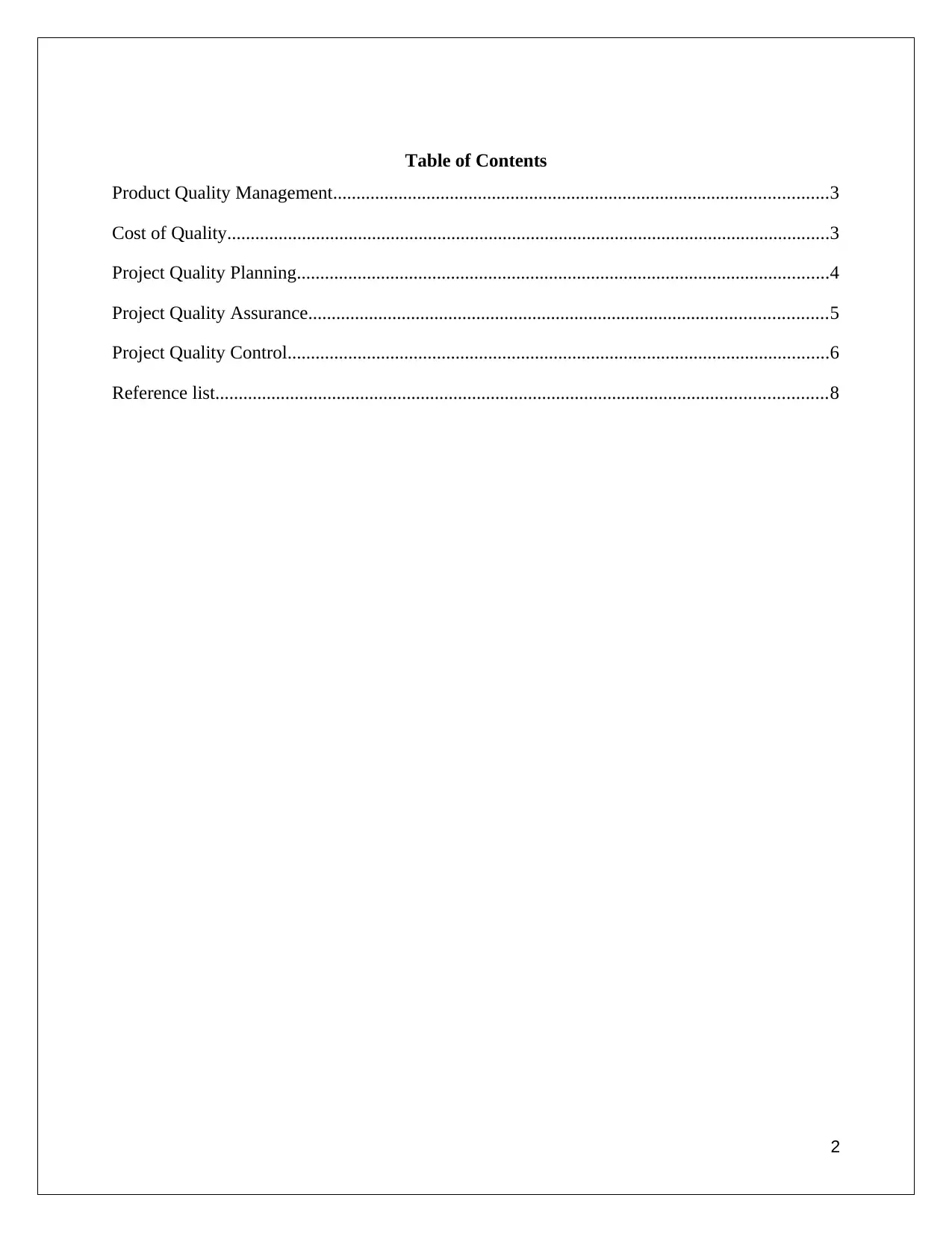
Table of Contents
Product Quality Management..........................................................................................................3
Cost of Quality.................................................................................................................................3
Project Quality Planning..................................................................................................................4
Project Quality Assurance...............................................................................................................5
Project Quality Control....................................................................................................................6
Reference list...................................................................................................................................8
2
Product Quality Management..........................................................................................................3
Cost of Quality.................................................................................................................................3
Project Quality Planning..................................................................................................................4
Project Quality Assurance...............................................................................................................5
Project Quality Control....................................................................................................................6
Reference list...................................................................................................................................8
2
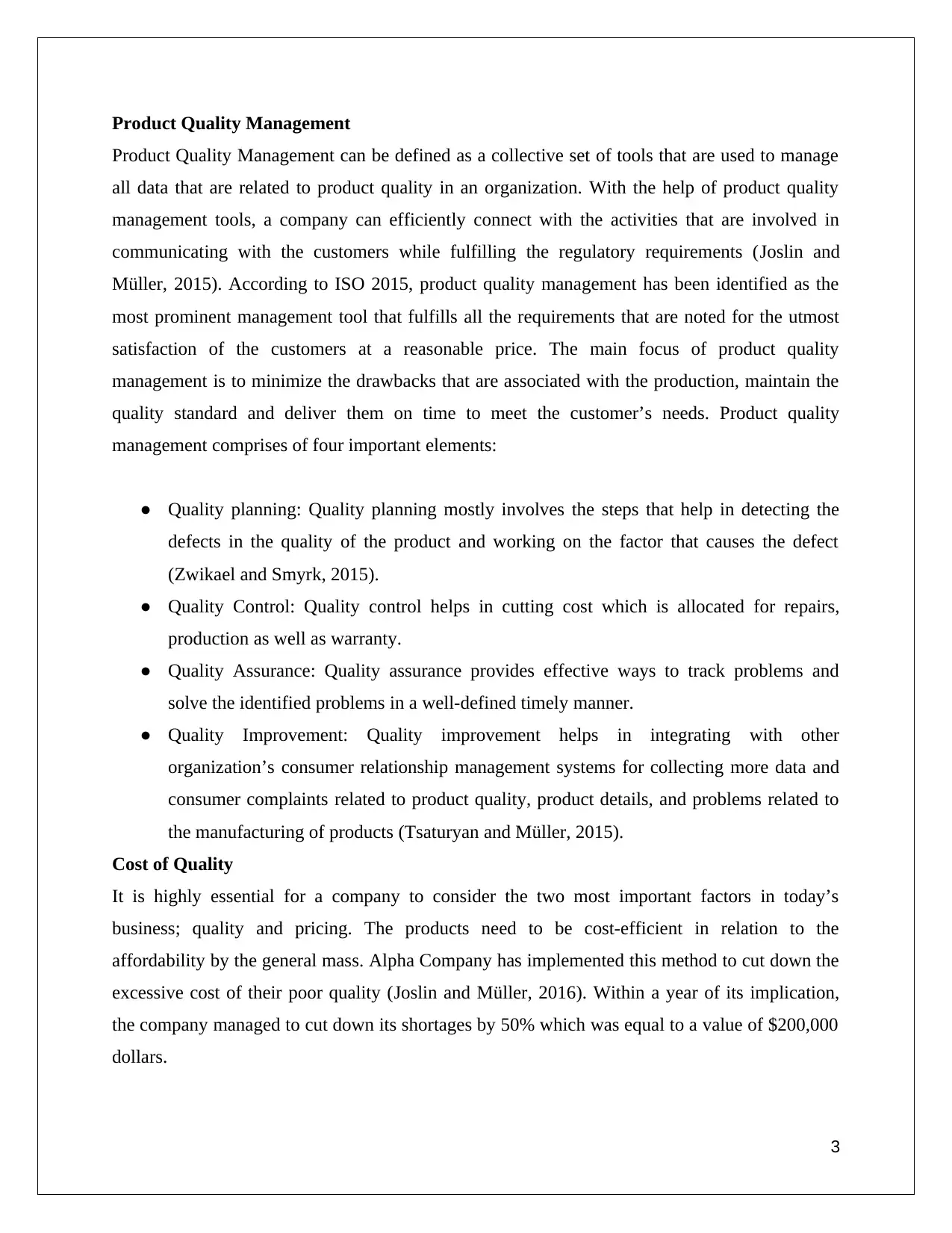
Product Quality Management
Product Quality Management can be defined as a collective set of tools that are used to manage
all data that are related to product quality in an organization. With the help of product quality
management tools, a company can efficiently connect with the activities that are involved in
communicating with the customers while fulfilling the regulatory requirements (Joslin and
Müller, 2015). According to ISO 2015, product quality management has been identified as the
most prominent management tool that fulfills all the requirements that are noted for the utmost
satisfaction of the customers at a reasonable price. The main focus of product quality
management is to minimize the drawbacks that are associated with the production, maintain the
quality standard and deliver them on time to meet the customer’s needs. Product quality
management comprises of four important elements:
● Quality planning: Quality planning mostly involves the steps that help in detecting the
defects in the quality of the product and working on the factor that causes the defect
(Zwikael and Smyrk, 2015).
● Quality Control: Quality control helps in cutting cost which is allocated for repairs,
production as well as warranty.
● Quality Assurance: Quality assurance provides effective ways to track problems and
solve the identified problems in a well-defined timely manner.
● Quality Improvement: Quality improvement helps in integrating with other
organization’s consumer relationship management systems for collecting more data and
consumer complaints related to product quality, product details, and problems related to
the manufacturing of products (Tsaturyan and Müller, 2015).
Cost of Quality
It is highly essential for a company to consider the two most important factors in today’s
business; quality and pricing. The products need to be cost-efficient in relation to the
affordability by the general mass. Alpha Company has implemented this method to cut down the
excessive cost of their poor quality (Joslin and Müller, 2016). Within a year of its implication,
the company managed to cut down its shortages by 50% which was equal to a value of $200,000
dollars.
3
Product Quality Management can be defined as a collective set of tools that are used to manage
all data that are related to product quality in an organization. With the help of product quality
management tools, a company can efficiently connect with the activities that are involved in
communicating with the customers while fulfilling the regulatory requirements (Joslin and
Müller, 2015). According to ISO 2015, product quality management has been identified as the
most prominent management tool that fulfills all the requirements that are noted for the utmost
satisfaction of the customers at a reasonable price. The main focus of product quality
management is to minimize the drawbacks that are associated with the production, maintain the
quality standard and deliver them on time to meet the customer’s needs. Product quality
management comprises of four important elements:
● Quality planning: Quality planning mostly involves the steps that help in detecting the
defects in the quality of the product and working on the factor that causes the defect
(Zwikael and Smyrk, 2015).
● Quality Control: Quality control helps in cutting cost which is allocated for repairs,
production as well as warranty.
● Quality Assurance: Quality assurance provides effective ways to track problems and
solve the identified problems in a well-defined timely manner.
● Quality Improvement: Quality improvement helps in integrating with other
organization’s consumer relationship management systems for collecting more data and
consumer complaints related to product quality, product details, and problems related to
the manufacturing of products (Tsaturyan and Müller, 2015).
Cost of Quality
It is highly essential for a company to consider the two most important factors in today’s
business; quality and pricing. The products need to be cost-efficient in relation to the
affordability by the general mass. Alpha Company has implemented this method to cut down the
excessive cost of their poor quality (Joslin and Müller, 2016). Within a year of its implication,
the company managed to cut down its shortages by 50% which was equal to a value of $200,000
dollars.
3
⊘ This is a preview!⊘
Do you want full access?
Subscribe today to unlock all pages.

Trusted by 1+ million students worldwide
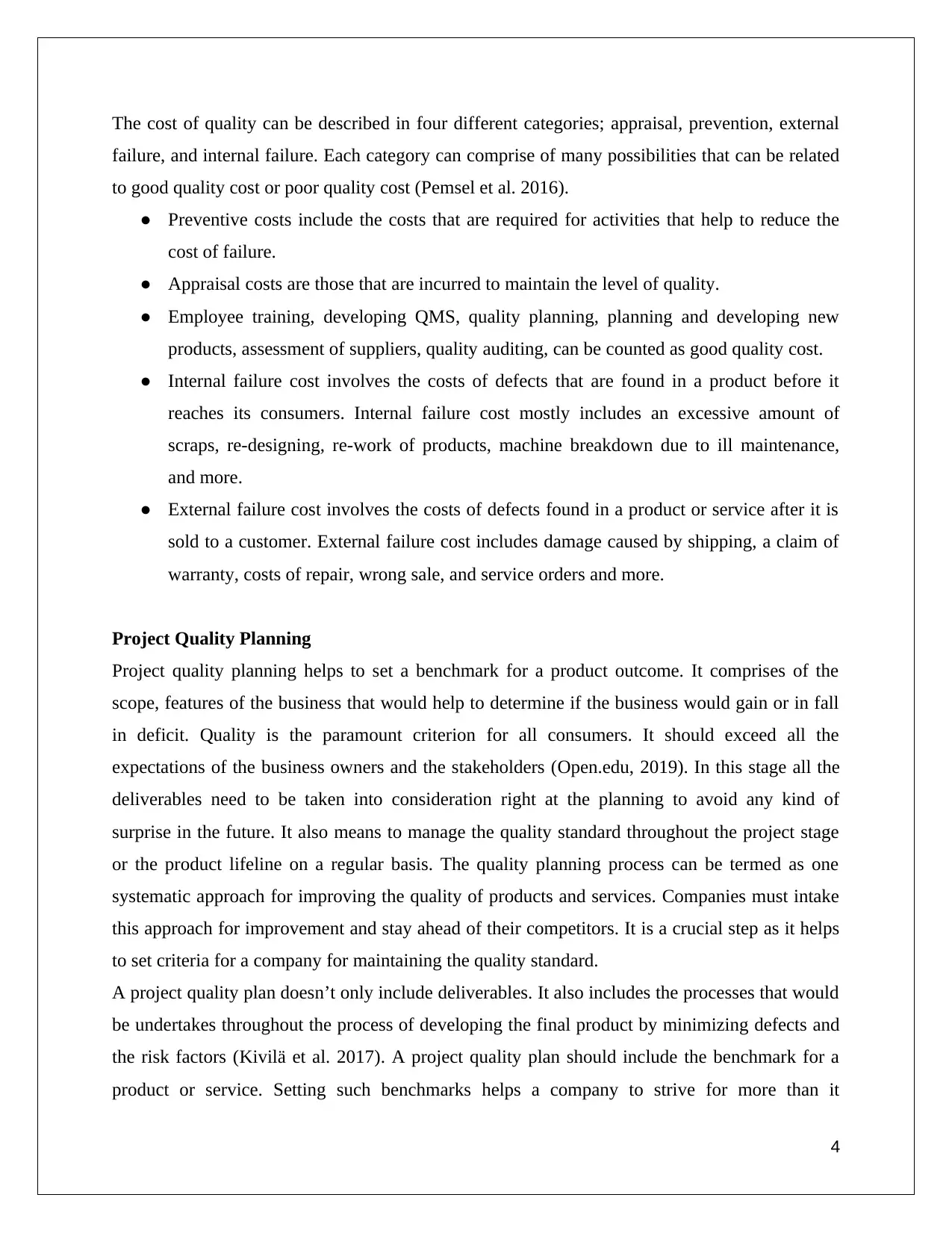
The cost of quality can be described in four different categories; appraisal, prevention, external
failure, and internal failure. Each category can comprise of many possibilities that can be related
to good quality cost or poor quality cost (Pemsel et al. 2016).
● Preventive costs include the costs that are required for activities that help to reduce the
cost of failure.
● Appraisal costs are those that are incurred to maintain the level of quality.
● Employee training, developing QMS, quality planning, planning and developing new
products, assessment of suppliers, quality auditing, can be counted as good quality cost.
● Internal failure cost involves the costs of defects that are found in a product before it
reaches its consumers. Internal failure cost mostly includes an excessive amount of
scraps, re-designing, re-work of products, machine breakdown due to ill maintenance,
and more.
● External failure cost involves the costs of defects found in a product or service after it is
sold to a customer. External failure cost includes damage caused by shipping, a claim of
warranty, costs of repair, wrong sale, and service orders and more.
Project Quality Planning
Project quality planning helps to set a benchmark for a product outcome. It comprises of the
scope, features of the business that would help to determine if the business would gain or in fall
in deficit. Quality is the paramount criterion for all consumers. It should exceed all the
expectations of the business owners and the stakeholders (Open.edu, 2019). In this stage all the
deliverables need to be taken into consideration right at the planning to avoid any kind of
surprise in the future. It also means to manage the quality standard throughout the project stage
or the product lifeline on a regular basis. The quality planning process can be termed as one
systematic approach for improving the quality of products and services. Companies must intake
this approach for improvement and stay ahead of their competitors. It is a crucial step as it helps
to set criteria for a company for maintaining the quality standard.
A project quality plan doesn’t only include deliverables. It also includes the processes that would
be undertakes throughout the process of developing the final product by minimizing defects and
the risk factors (Kivilä et al. 2017). A project quality plan should include the benchmark for a
product or service. Setting such benchmarks helps a company to strive for more than it
4
failure, and internal failure. Each category can comprise of many possibilities that can be related
to good quality cost or poor quality cost (Pemsel et al. 2016).
● Preventive costs include the costs that are required for activities that help to reduce the
cost of failure.
● Appraisal costs are those that are incurred to maintain the level of quality.
● Employee training, developing QMS, quality planning, planning and developing new
products, assessment of suppliers, quality auditing, can be counted as good quality cost.
● Internal failure cost involves the costs of defects that are found in a product before it
reaches its consumers. Internal failure cost mostly includes an excessive amount of
scraps, re-designing, re-work of products, machine breakdown due to ill maintenance,
and more.
● External failure cost involves the costs of defects found in a product or service after it is
sold to a customer. External failure cost includes damage caused by shipping, a claim of
warranty, costs of repair, wrong sale, and service orders and more.
Project Quality Planning
Project quality planning helps to set a benchmark for a product outcome. It comprises of the
scope, features of the business that would help to determine if the business would gain or in fall
in deficit. Quality is the paramount criterion for all consumers. It should exceed all the
expectations of the business owners and the stakeholders (Open.edu, 2019). In this stage all the
deliverables need to be taken into consideration right at the planning to avoid any kind of
surprise in the future. It also means to manage the quality standard throughout the project stage
or the product lifeline on a regular basis. The quality planning process can be termed as one
systematic approach for improving the quality of products and services. Companies must intake
this approach for improvement and stay ahead of their competitors. It is a crucial step as it helps
to set criteria for a company for maintaining the quality standard.
A project quality plan doesn’t only include deliverables. It also includes the processes that would
be undertakes throughout the process of developing the final product by minimizing defects and
the risk factors (Kivilä et al. 2017). A project quality plan should include the benchmark for a
product or service. Setting such benchmarks helps a company to strive for more than it
4
Paraphrase This Document
Need a fresh take? Get an instant paraphrase of this document with our AI Paraphraser
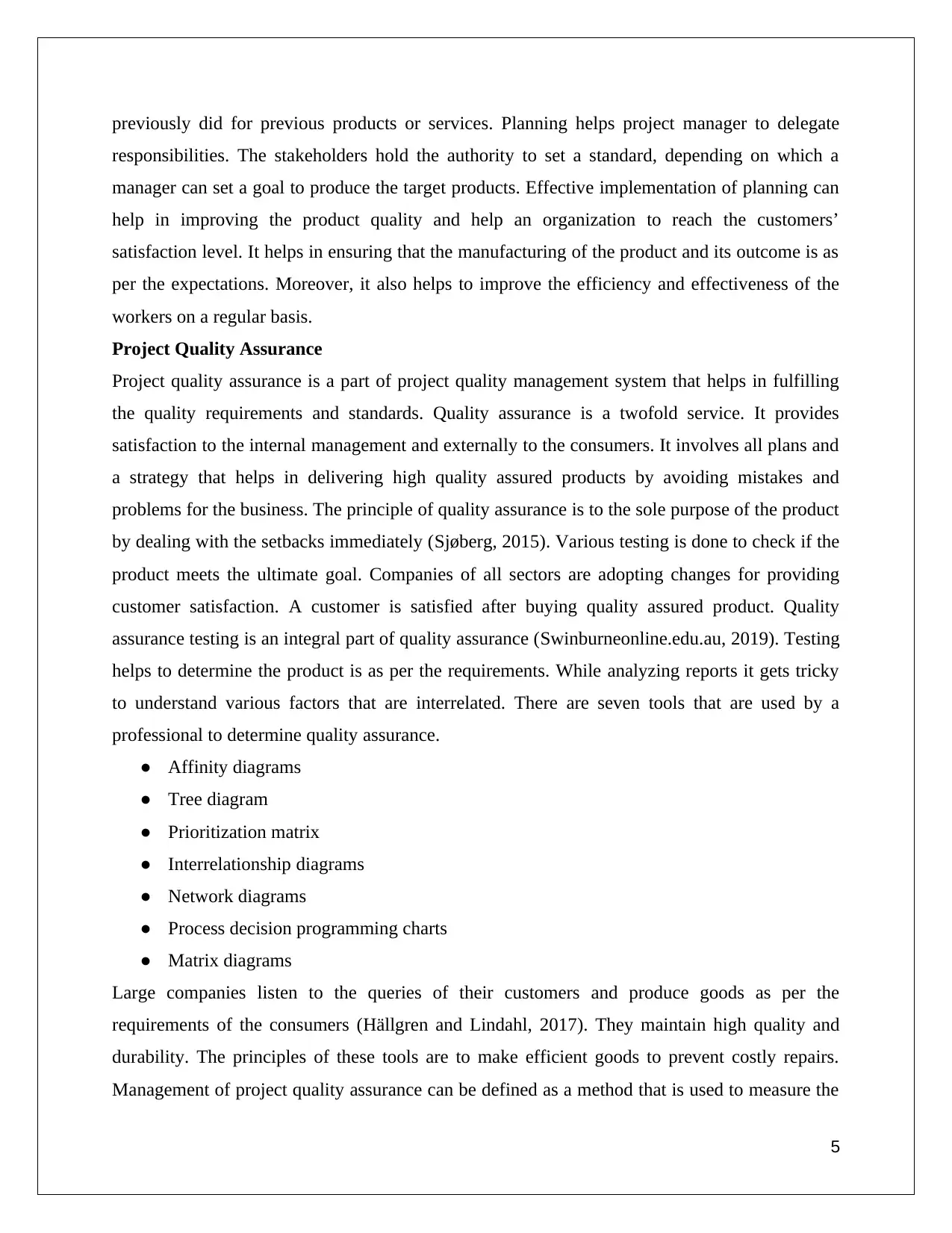
previously did for previous products or services. Planning helps project manager to delegate
responsibilities. The stakeholders hold the authority to set a standard, depending on which a
manager can set a goal to produce the target products. Effective implementation of planning can
help in improving the product quality and help an organization to reach the customers’
satisfaction level. It helps in ensuring that the manufacturing of the product and its outcome is as
per the expectations. Moreover, it also helps to improve the efficiency and effectiveness of the
workers on a regular basis.
Project Quality Assurance
Project quality assurance is a part of project quality management system that helps in fulfilling
the quality requirements and standards. Quality assurance is a twofold service. It provides
satisfaction to the internal management and externally to the consumers. It involves all plans and
a strategy that helps in delivering high quality assured products by avoiding mistakes and
problems for the business. The principle of quality assurance is to the sole purpose of the product
by dealing with the setbacks immediately (Sjøberg, 2015). Various testing is done to check if the
product meets the ultimate goal. Companies of all sectors are adopting changes for providing
customer satisfaction. A customer is satisfied after buying quality assured product. Quality
assurance testing is an integral part of quality assurance (Swinburneonline.edu.au, 2019). Testing
helps to determine the product is as per the requirements. While analyzing reports it gets tricky
to understand various factors that are interrelated. There are seven tools that are used by a
professional to determine quality assurance.
● Affinity diagrams
● Tree diagram
● Prioritization matrix
● Interrelationship diagrams
● Network diagrams
● Process decision programming charts
● Matrix diagrams
Large companies listen to the queries of their customers and produce goods as per the
requirements of the consumers (Hällgren and Lindahl, 2017). They maintain high quality and
durability. The principles of these tools are to make efficient goods to prevent costly repairs.
Management of project quality assurance can be defined as a method that is used to measure the
5
responsibilities. The stakeholders hold the authority to set a standard, depending on which a
manager can set a goal to produce the target products. Effective implementation of planning can
help in improving the product quality and help an organization to reach the customers’
satisfaction level. It helps in ensuring that the manufacturing of the product and its outcome is as
per the expectations. Moreover, it also helps to improve the efficiency and effectiveness of the
workers on a regular basis.
Project Quality Assurance
Project quality assurance is a part of project quality management system that helps in fulfilling
the quality requirements and standards. Quality assurance is a twofold service. It provides
satisfaction to the internal management and externally to the consumers. It involves all plans and
a strategy that helps in delivering high quality assured products by avoiding mistakes and
problems for the business. The principle of quality assurance is to the sole purpose of the product
by dealing with the setbacks immediately (Sjøberg, 2015). Various testing is done to check if the
product meets the ultimate goal. Companies of all sectors are adopting changes for providing
customer satisfaction. A customer is satisfied after buying quality assured product. Quality
assurance testing is an integral part of quality assurance (Swinburneonline.edu.au, 2019). Testing
helps to determine the product is as per the requirements. While analyzing reports it gets tricky
to understand various factors that are interrelated. There are seven tools that are used by a
professional to determine quality assurance.
● Affinity diagrams
● Tree diagram
● Prioritization matrix
● Interrelationship diagrams
● Network diagrams
● Process decision programming charts
● Matrix diagrams
Large companies listen to the queries of their customers and produce goods as per the
requirements of the consumers (Hällgren and Lindahl, 2017). They maintain high quality and
durability. The principles of these tools are to make efficient goods to prevent costly repairs.
Management of project quality assurance can be defined as a method that is used to measure the
5
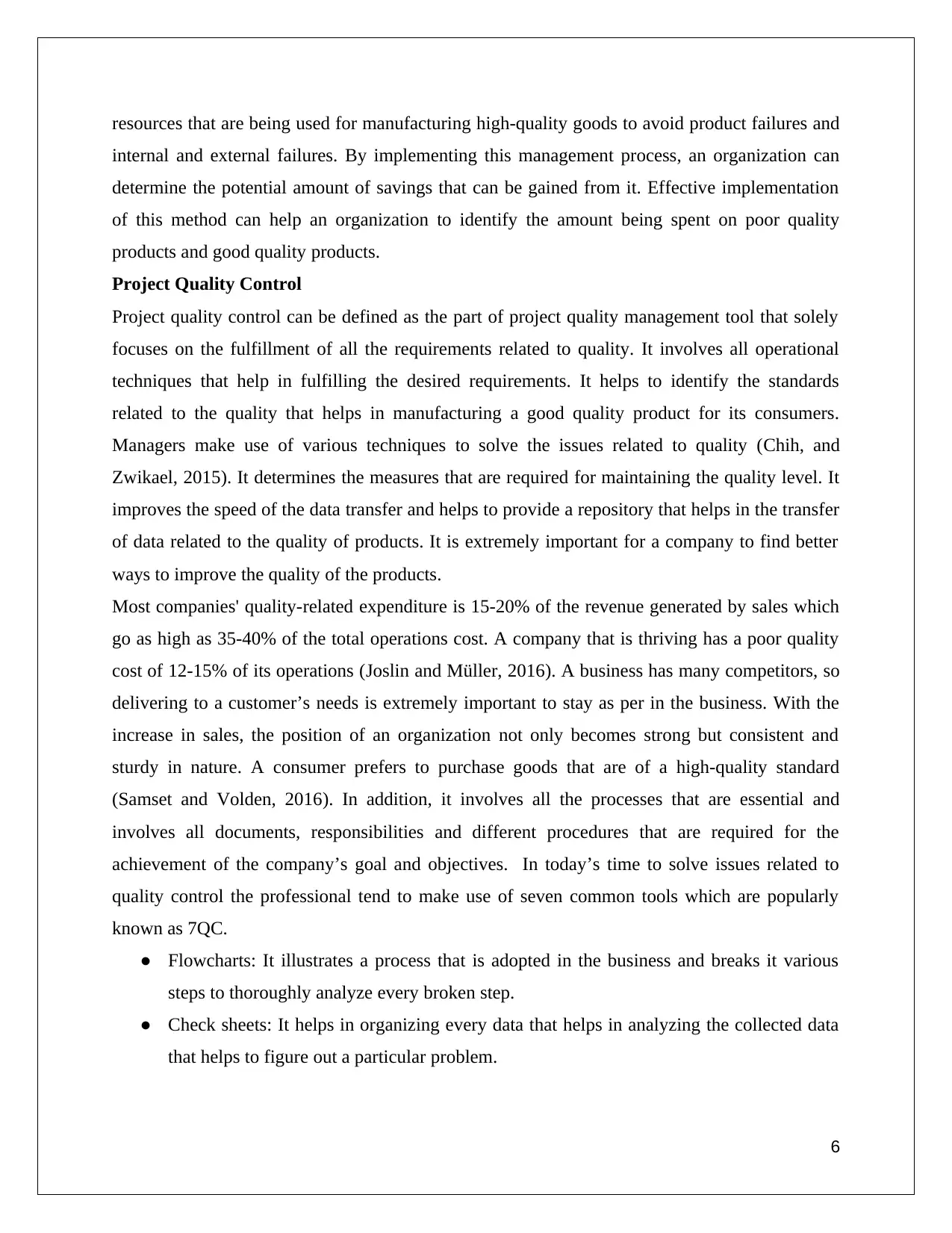
resources that are being used for manufacturing high-quality goods to avoid product failures and
internal and external failures. By implementing this management process, an organization can
determine the potential amount of savings that can be gained from it. Effective implementation
of this method can help an organization to identify the amount being spent on poor quality
products and good quality products.
Project Quality Control
Project quality control can be defined as the part of project quality management tool that solely
focuses on the fulfillment of all the requirements related to quality. It involves all operational
techniques that help in fulfilling the desired requirements. It helps to identify the standards
related to the quality that helps in manufacturing a good quality product for its consumers.
Managers make use of various techniques to solve the issues related to quality (Chih, and
Zwikael, 2015). It determines the measures that are required for maintaining the quality level. It
improves the speed of the data transfer and helps to provide a repository that helps in the transfer
of data related to the quality of products. It is extremely important for a company to find better
ways to improve the quality of the products.
Most companies' quality-related expenditure is 15-20% of the revenue generated by sales which
go as high as 35-40% of the total operations cost. A company that is thriving has a poor quality
cost of 12-15% of its operations (Joslin and Müller, 2016). A business has many competitors, so
delivering to a customer’s needs is extremely important to stay as per in the business. With the
increase in sales, the position of an organization not only becomes strong but consistent and
sturdy in nature. A consumer prefers to purchase goods that are of a high-quality standard
(Samset and Volden, 2016). In addition, it involves all the processes that are essential and
involves all documents, responsibilities and different procedures that are required for the
achievement of the company’s goal and objectives. In today’s time to solve issues related to
quality control the professional tend to make use of seven common tools which are popularly
known as 7QC.
● Flowcharts: It illustrates a process that is adopted in the business and breaks it various
steps to thoroughly analyze every broken step.
● Check sheets: It helps in organizing every data that helps in analyzing the collected data
that helps to figure out a particular problem.
6
internal and external failures. By implementing this management process, an organization can
determine the potential amount of savings that can be gained from it. Effective implementation
of this method can help an organization to identify the amount being spent on poor quality
products and good quality products.
Project Quality Control
Project quality control can be defined as the part of project quality management tool that solely
focuses on the fulfillment of all the requirements related to quality. It involves all operational
techniques that help in fulfilling the desired requirements. It helps to identify the standards
related to the quality that helps in manufacturing a good quality product for its consumers.
Managers make use of various techniques to solve the issues related to quality (Chih, and
Zwikael, 2015). It determines the measures that are required for maintaining the quality level. It
improves the speed of the data transfer and helps to provide a repository that helps in the transfer
of data related to the quality of products. It is extremely important for a company to find better
ways to improve the quality of the products.
Most companies' quality-related expenditure is 15-20% of the revenue generated by sales which
go as high as 35-40% of the total operations cost. A company that is thriving has a poor quality
cost of 12-15% of its operations (Joslin and Müller, 2016). A business has many competitors, so
delivering to a customer’s needs is extremely important to stay as per in the business. With the
increase in sales, the position of an organization not only becomes strong but consistent and
sturdy in nature. A consumer prefers to purchase goods that are of a high-quality standard
(Samset and Volden, 2016). In addition, it involves all the processes that are essential and
involves all documents, responsibilities and different procedures that are required for the
achievement of the company’s goal and objectives. In today’s time to solve issues related to
quality control the professional tend to make use of seven common tools which are popularly
known as 7QC.
● Flowcharts: It illustrates a process that is adopted in the business and breaks it various
steps to thoroughly analyze every broken step.
● Check sheets: It helps in organizing every data that helps in analyzing the collected data
that helps to figure out a particular problem.
6
⊘ This is a preview!⊘
Do you want full access?
Subscribe today to unlock all pages.

Trusted by 1+ million students worldwide
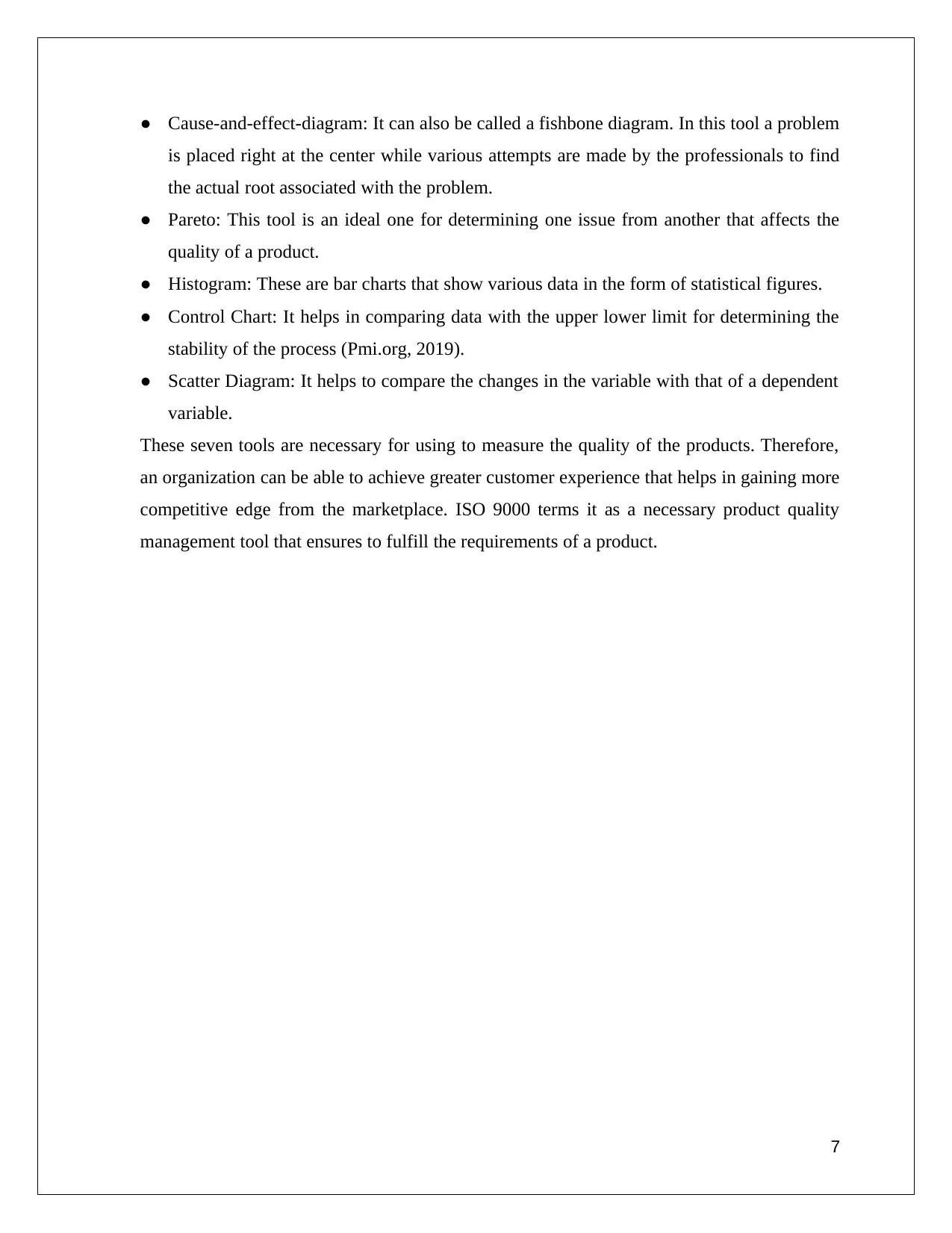
● Cause-and-effect-diagram: It can also be called a fishbone diagram. In this tool a problem
is placed right at the center while various attempts are made by the professionals to find
the actual root associated with the problem.
● Pareto: This tool is an ideal one for determining one issue from another that affects the
quality of a product.
● Histogram: These are bar charts that show various data in the form of statistical figures.
● Control Chart: It helps in comparing data with the upper lower limit for determining the
stability of the process (Pmi.org, 2019).
● Scatter Diagram: It helps to compare the changes in the variable with that of a dependent
variable.
These seven tools are necessary for using to measure the quality of the products. Therefore,
an organization can be able to achieve greater customer experience that helps in gaining more
competitive edge from the marketplace. ISO 9000 terms it as a necessary product quality
management tool that ensures to fulfill the requirements of a product.
7
is placed right at the center while various attempts are made by the professionals to find
the actual root associated with the problem.
● Pareto: This tool is an ideal one for determining one issue from another that affects the
quality of a product.
● Histogram: These are bar charts that show various data in the form of statistical figures.
● Control Chart: It helps in comparing data with the upper lower limit for determining the
stability of the process (Pmi.org, 2019).
● Scatter Diagram: It helps to compare the changes in the variable with that of a dependent
variable.
These seven tools are necessary for using to measure the quality of the products. Therefore,
an organization can be able to achieve greater customer experience that helps in gaining more
competitive edge from the marketplace. ISO 9000 terms it as a necessary product quality
management tool that ensures to fulfill the requirements of a product.
7
Paraphrase This Document
Need a fresh take? Get an instant paraphrase of this document with our AI Paraphraser
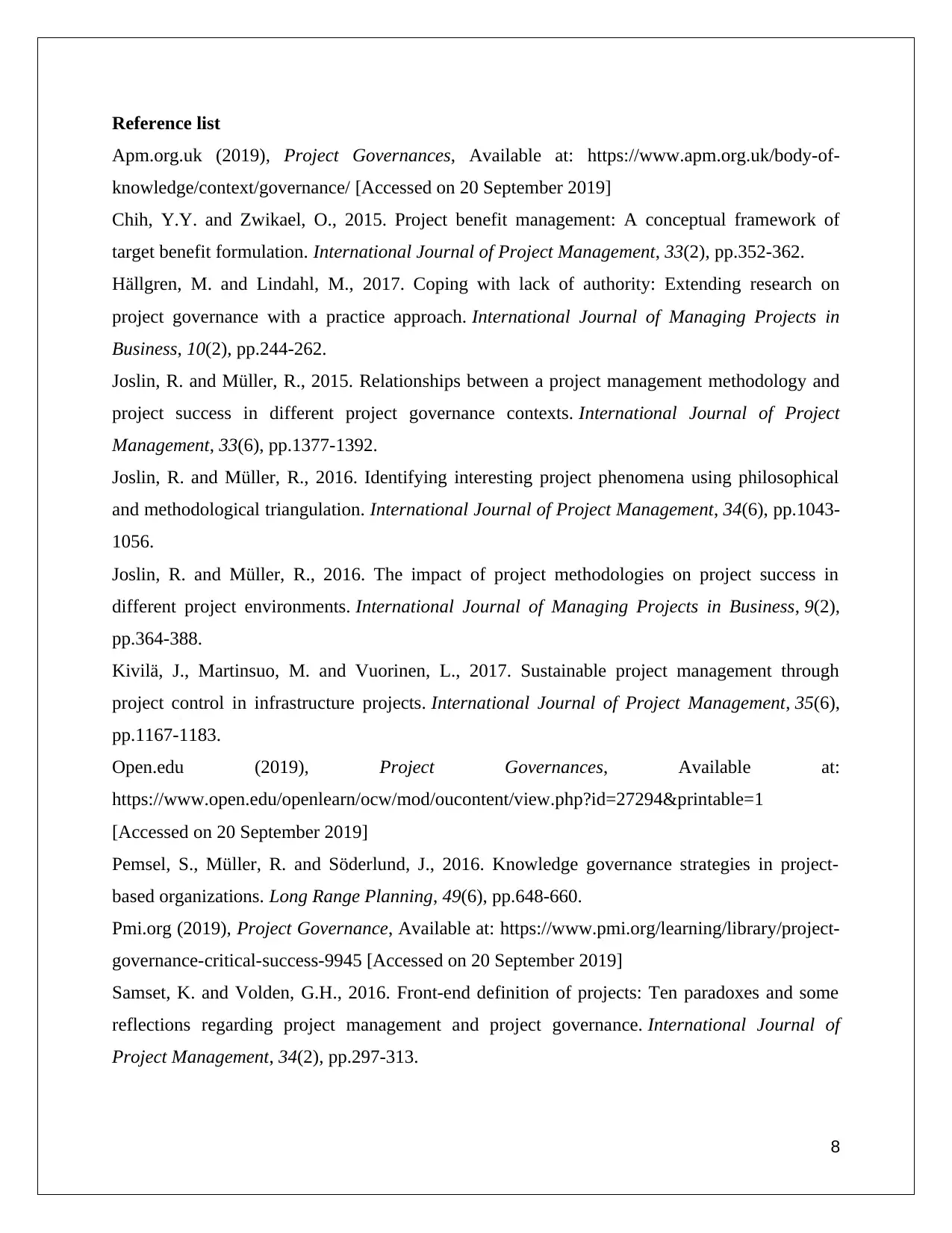
Reference list
Apm.org.uk (2019), Project Governances, Available at: https://www.apm.org.uk/body-of-
knowledge/context/governance/ [Accessed on 20 September 2019]
Chih, Y.Y. and Zwikael, O., 2015. Project benefit management: A conceptual framework of
target benefit formulation. International Journal of Project Management, 33(2), pp.352-362.
Hällgren, M. and Lindahl, M., 2017. Coping with lack of authority: Extending research on
project governance with a practice approach. International Journal of Managing Projects in
Business, 10(2), pp.244-262.
Joslin, R. and Müller, R., 2015. Relationships between a project management methodology and
project success in different project governance contexts. International Journal of Project
Management, 33(6), pp.1377-1392.
Joslin, R. and Müller, R., 2016. Identifying interesting project phenomena using philosophical
and methodological triangulation. International Journal of Project Management, 34(6), pp.1043-
1056.
Joslin, R. and Müller, R., 2016. The impact of project methodologies on project success in
different project environments. International Journal of Managing Projects in Business, 9(2),
pp.364-388.
Kivilä, J., Martinsuo, M. and Vuorinen, L., 2017. Sustainable project management through
project control in infrastructure projects. International Journal of Project Management, 35(6),
pp.1167-1183.
Open.edu (2019), Project Governances, Available at:
https://www.open.edu/openlearn/ocw/mod/oucontent/view.php?id=27294&printable=1
[Accessed on 20 September 2019]
Pemsel, S., Müller, R. and Söderlund, J., 2016. Knowledge governance strategies in project-
based organizations. Long Range Planning, 49(6), pp.648-660.
Pmi.org (2019), Project Governance, Available at: https://www.pmi.org/learning/library/project-
governance-critical-success-9945 [Accessed on 20 September 2019]
Samset, K. and Volden, G.H., 2016. Front-end definition of projects: Ten paradoxes and some
reflections regarding project management and project governance. International Journal of
Project Management, 34(2), pp.297-313.
8
Apm.org.uk (2019), Project Governances, Available at: https://www.apm.org.uk/body-of-
knowledge/context/governance/ [Accessed on 20 September 2019]
Chih, Y.Y. and Zwikael, O., 2015. Project benefit management: A conceptual framework of
target benefit formulation. International Journal of Project Management, 33(2), pp.352-362.
Hällgren, M. and Lindahl, M., 2017. Coping with lack of authority: Extending research on
project governance with a practice approach. International Journal of Managing Projects in
Business, 10(2), pp.244-262.
Joslin, R. and Müller, R., 2015. Relationships between a project management methodology and
project success in different project governance contexts. International Journal of Project
Management, 33(6), pp.1377-1392.
Joslin, R. and Müller, R., 2016. Identifying interesting project phenomena using philosophical
and methodological triangulation. International Journal of Project Management, 34(6), pp.1043-
1056.
Joslin, R. and Müller, R., 2016. The impact of project methodologies on project success in
different project environments. International Journal of Managing Projects in Business, 9(2),
pp.364-388.
Kivilä, J., Martinsuo, M. and Vuorinen, L., 2017. Sustainable project management through
project control in infrastructure projects. International Journal of Project Management, 35(6),
pp.1167-1183.
Open.edu (2019), Project Governances, Available at:
https://www.open.edu/openlearn/ocw/mod/oucontent/view.php?id=27294&printable=1
[Accessed on 20 September 2019]
Pemsel, S., Müller, R. and Söderlund, J., 2016. Knowledge governance strategies in project-
based organizations. Long Range Planning, 49(6), pp.648-660.
Pmi.org (2019), Project Governance, Available at: https://www.pmi.org/learning/library/project-
governance-critical-success-9945 [Accessed on 20 September 2019]
Samset, K. and Volden, G.H., 2016. Front-end definition of projects: Ten paradoxes and some
reflections regarding project management and project governance. International Journal of
Project Management, 34(2), pp.297-313.
8
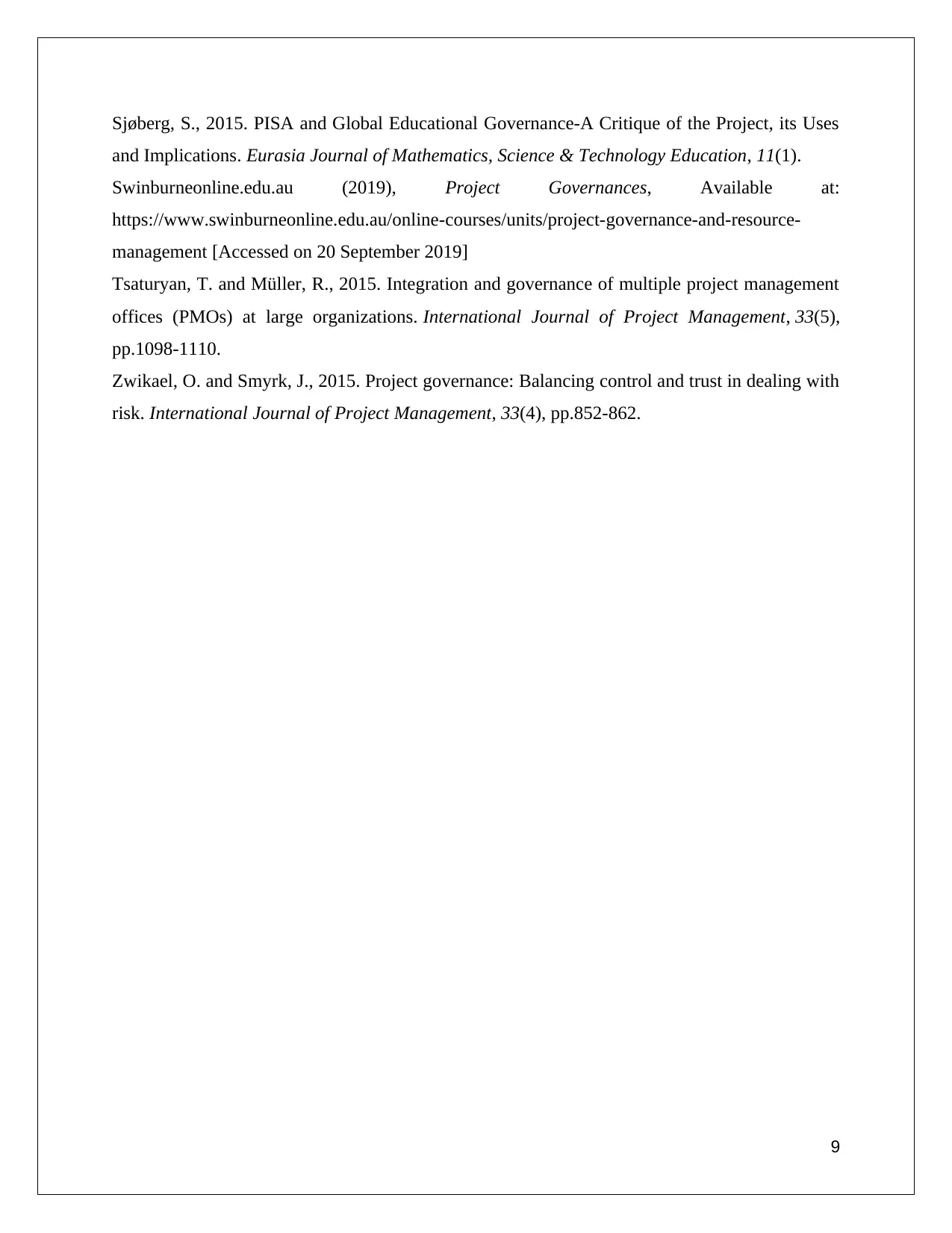
Sjøberg, S., 2015. PISA and Global Educational Governance-A Critique of the Project, its Uses
and Implications. Eurasia Journal of Mathematics, Science & Technology Education, 11(1).
Swinburneonline.edu.au (2019), Project Governances, Available at:
https://www.swinburneonline.edu.au/online-courses/units/project-governance-and-resource-
management [Accessed on 20 September 2019]
Tsaturyan, T. and Müller, R., 2015. Integration and governance of multiple project management
offices (PMOs) at large organizations. International Journal of Project Management, 33(5),
pp.1098-1110.
Zwikael, O. and Smyrk, J., 2015. Project governance: Balancing control and trust in dealing with
risk. International Journal of Project Management, 33(4), pp.852-862.
9
and Implications. Eurasia Journal of Mathematics, Science & Technology Education, 11(1).
Swinburneonline.edu.au (2019), Project Governances, Available at:
https://www.swinburneonline.edu.au/online-courses/units/project-governance-and-resource-
management [Accessed on 20 September 2019]
Tsaturyan, T. and Müller, R., 2015. Integration and governance of multiple project management
offices (PMOs) at large organizations. International Journal of Project Management, 33(5),
pp.1098-1110.
Zwikael, O. and Smyrk, J., 2015. Project governance: Balancing control and trust in dealing with
risk. International Journal of Project Management, 33(4), pp.852-862.
9
⊘ This is a preview!⊘
Do you want full access?
Subscribe today to unlock all pages.

Trusted by 1+ million students worldwide
1 out of 9
Related Documents
Your All-in-One AI-Powered Toolkit for Academic Success.
+13062052269
info@desklib.com
Available 24*7 on WhatsApp / Email
![[object Object]](/_next/static/media/star-bottom.7253800d.svg)
Unlock your academic potential
Copyright © 2020–2025 A2Z Services. All Rights Reserved. Developed and managed by ZUCOL.




